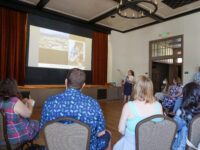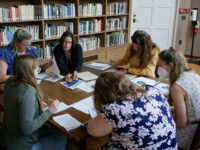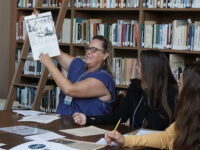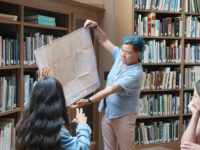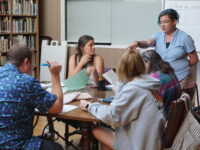
03 Oct The Making of Monuments
October 3, 2023
Monuments stand to commemorate what is important to a community, telling a story about the people they represent. But who gets to decide what stories are told? And what happens when the values of a community change, and when the community itself changes?
This summer, the IHC brought together eight local teachers, three history Ph.D. students, and community partners at the Santa Barbara Trust for Historic Preservation to create lessons for elementary school students around questions of history, memory, and representation, organized around a statue of a Spanish king located at the Santa Barbara Presidio.
The week-long workshop consisted of daily meetings, discussions, and collaborations in small groups. Working with graduate students, teachers explored the meaning and importance of monuments and then used these insights to design activities to encourage students to recognize and reconsider the monuments in their communities.
Teachers got to know the statue of King Carlos III, the object of their study. Carlos III was the King of Spain when the Santa Barbara Presidio was founded in 1782. The statue was a gift to the city of Santa Barbara from King Juan Carlos I of Spain to commemorate the Presidio’s 200th anniversary. Initially installed near De La Guerra Plaza, it now stands in the courtyard at the Presidio, where it was relocated in 1992 following repeated defacements and calls for its removal. A tour of the Presidio and surrounding neighborhood helped teachers build on their understanding of the history of the community and put the statue in its local and historic context.
The Presidio Research Center archive was the next stop. The archive houses a variety of sources related to the statue, from newspaper clippings, to city council records, to correspondence with the King of Spain. From these firsthand accounts, teachers learned about the story that the statue was intended to tell and the controversy that ensued when it was initially installed and later relocated.
These archival materials became the primary sources for their lessons. Partnering with graduate students from the UCSB History Department, teachers developed creative approaches to bringing these sources into the classroom. In mock debates, travel brochures, letters to civic leaders, and artistic designs, students will now consider how these sources help them understand the statue and what it represents.
By the end of a week that teachers described as “amazing” and “inspiring,” each educator left with a deeper knowledge about the multilayered history of Santa Barbara, new connections with colleagues from across the school district, and exciting lesson plans to use in their classrooms this year.
The Making of Monuments project will continue throughout the 2023-24 school year. Field trips to the Presidio and the statue of Carlos III will complement lessons in the classroom. And a journey to the UCSB campus will provide students with the opportunity to apply their analytical skills to another statue, Gaucho Argentino, located at the Mosher Alumni House.
Students will finish the year with a new understanding of the significance of monuments and the stories they tell, as well as their relationship with the communities in which they reside. Students will also develop a stronger appreciation of their own power and responsibility as community members to preserve, change, or reimagine the monuments and stories that represent them.
The project is a collaboration between the IHC, educators from the Santa Barbara Unified School District, the Santa Barbara Trust for Historic Preservation (SBTHP), and graduate students from the UCSB History Department. The Making of Monuments was supported by a grant from the UCSB Office of Diversity, Equity, and Inclusion. The IHC would like to extend a special thank you to educators Jonathan Combs (Adams Elementary), Shalon Edwards (Santa Barbara Charter), Jen Griffith (Washington Elementary), Erin Mitchell (Adams Elementary), Donna Nelson (Adams Elementary), Elizabeth Oakley (Adams Elementary), Geraldine Salhuana (McKinley Elementary), and Jenny Witherell (Santa Barbara Charter). We also extend our thanks to our amazing colleagues at SBTHP: Executive Director Anne Peterson, Board Member Mia Lopez, Associate Director for Public Engagement Kevin McGarry, and Director of Presidio Research Center Dez Alaniz. Thank you also to our skilled and enthusiastic graduate students Emma Bianco, Casey Haughin-Scasny, and Dana Hughes for their outstanding contributions to the project.


